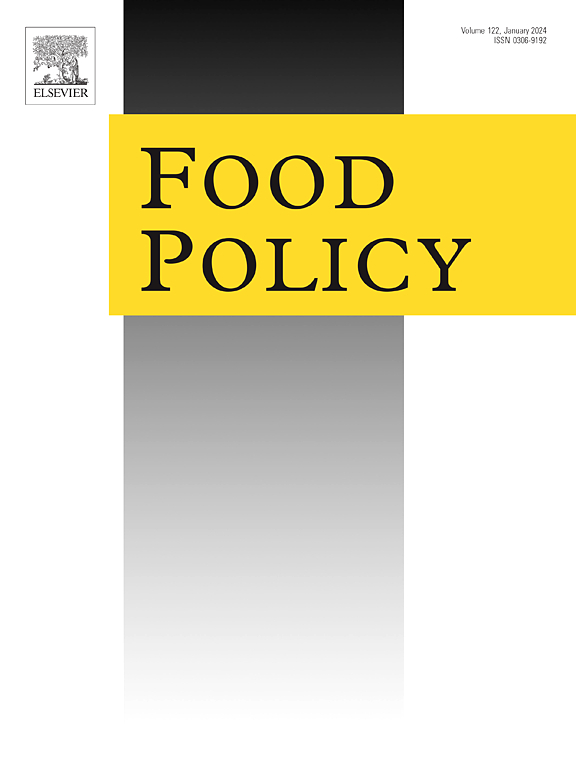全球冲击与当地卖家:肯尼亚肥料市场对燃料-肥料-食品价格危机的反应
IF 6
1区 经济学
Q1 AGRICULTURAL ECONOMICS & POLICY
引用次数: 0
摘要
在2020-2022年燃料-肥料-粮食危机期间,全球化肥价格翻了一番,使2.1亿人陷入严重粮食不安全状况。我们使用来自农产品经销商的交易级数据来分析这种全球冲击是如何通过肯尼亚零售市场传播的。全球价格冲击如何在农村市场蔓延,影响低收入国家的企业和农民,人们仍然知之甚少。我们发现,肯尼亚化肥零售价格在危机期间平均上涨了81%,各商店之间的空间差异很大,从下降5%到上涨138%不等。我们使用二元面板分析来确定肯尼亚化肥零售商在价格传递和市场整合方面的变化,并评估政府政策干预的效果。我们发现了不对称价格传导的证据;农产品经销商价格对进口价格上涨的反应要快于对进口价格下跌的反应。研究表明,相对于高贫困地区,规模较大的商店和主要农业生产区的价格传导速度更快,与进口市场的整合程度也更强。肯尼亚国家肥料补贴计划减缓了价格传递,但可能延长了化肥零售价格的上涨。我们的研究结果表明,农民从投入价格下降中获益的速度不如对称传导下的那样快。我们的研究结果还表明,全球冲击在不同市场之间的传导是不均匀的,这表明有效的稳定政策应该考虑到市场条件的异质性和不同的传导行为。本文章由计算机程序翻译,如有差异,请以英文原文为准。
Global shocks and local sellers: Kenyan fertilizer markets’ response to the fuel-fertilizer-food price crisis
Global fertilizer prices doubled during the 2020–2022 fuel-fertilizer-food crisis, pushing an additional 210 million people into acute food insecurity. We use transaction-level data from agro-dealers to analyze how this global shock transmitted through Kenyan retail markets. How global price shocks spread across rural markets to affect firms and farmers in low-income countries remains poorly understood. We show that retail fertilizer prices in Kenya rose 81% on average during the crisis, with remarkable spatial variation ranging from 5% decreases to 138% increases across shops. We use dyadic panel analysis to identify changes in price transmission and in market integration across Kenyan fertilizer retailers and to evaluate the effects of government policy intervention. We find evidence of asymmetric price transmission; agro-dealer prices responded faster to import price increases than decreases. We show that larger shops and major agricultural production zones experienced faster price transmission and stronger integration with import markets relative to high-poverty areas. Kenya’s National Fertilizer Subsidy Program slowed price transmission but may have prolonged higher fertilizer retail prices. Our results imply that farmers do not benefit as rapidly from input price reductions as they would under symmetric transmission. Our results also demonstrate that global shocks transmit unevenly across markets, suggesting effective stabilization policies should account for heterogeneity in market conditions and variable pass-through behavior.
求助全文
通过发布文献求助,成功后即可免费获取论文全文。
去求助
来源期刊

Food Policy
管理科学-农业经济与政策
CiteScore
11.40
自引率
4.60%
发文量
128
审稿时长
62 days
期刊介绍:
Food Policy is a multidisciplinary journal publishing original research and novel evidence on issues in the formulation, implementation, and evaluation of policies for the food sector in developing, transition, and advanced economies.
Our main focus is on the economic and social aspect of food policy, and we prioritize empirical studies informing international food policy debates. Provided that articles make a clear and explicit contribution to food policy debates of international interest, we consider papers from any of the social sciences. Papers from other disciplines (e.g., law) will be considered only if they provide a key policy contribution, and are written in a style which is accessible to a social science readership.
 求助内容:
求助内容: 应助结果提醒方式:
应助结果提醒方式:


